
 Quadrature FM Detectors
Quadrature FM Detectors
This side presents some facts about Quadrature FM Detectors.
All contribution to this page are most welcome
Background
FM stands for Frequency Modulation. It means that the RF-frequency will change
acording to the input audio signal.
Example: A FM radio signal at 105.1MHz will not be exactly stable at 105.1MHz,
The audio signal in the RF will modulate (change) the frequency for about +/-
37.5kHz. There are some narrow band (field communication) wich only modulate
the frequency 1-5kHz.
There are some different way to bring out the sound from the RF-signal. I will
explain a way by using a "quad coil".
A FM demodulator produces an output voltage that is proportional to the instantaneous
frequency of the input.
There are three general categories of FM demodulator circuit:
Phase-locked loop (PLL) demodulator
Slope detection/FM discriminator
Quadrature detector
They all produce an output voltage proportional to the instantaneous input frequency.
I will not explain the two first types, but I will explain more about the last
one.
Quadrature FM Detectors
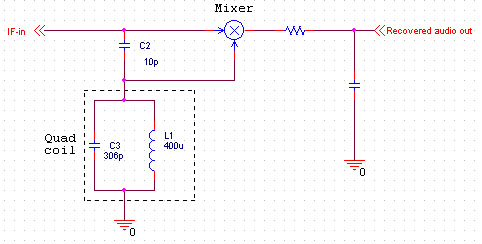
Quadrature FM detectors use a high-reactance capacitor (C2) to produce two signals
with a 90 degree phase difference. The phase-shifted signal is then applied to
an LC-tuned resonant at the carrier frequency (L1 and C3). Frequency changes will
then produce an additional leading or lagging phase shift into the mixer.

The diagram at right shows the impedance and the phase of a LC tuned circuit at
455kHz.
As you can see, the phase (red curve) is 0 at the resonans. If the frequency is
lower than 455kHz then phase angle is positive and if the frequency is higher
than 455kHz the phase angle is negative.
Conclution: If the frequency changes the phase will also vary and the output voltage
(audio signal) to.
RULE: a multiplication of two periodic signals with
the same frequency produces a DC voltage that is
directly proportional to the signal phase difference.
For small phase-shift (narrow band FM), the output will be reasonably linear.
The two most common frequency for detection is 455kHz and 10.7MHz.
For the 455kHz, you can use a (Yellow-slug) IF-can as quad-coil.
For the 10.7MHz you can use a (Green-slug) IF-can
as quad-coil.
Let see what that quad coil looks like.
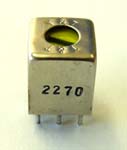
This is what the 455kHz IF can looks like.
The house is in metalic material and the core is of a ferrite material.
The yellow core can be screwed to finetune the resonans.
Sometime it can be tricky to remove the interial from the can, so be gentle.
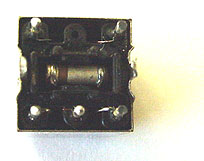
Bottom view
This is the bottom view of the can.
In the middle you can see the capacitor.
The lead from the capacitor goes up in the house and are connected to pin 1
and pin 3.
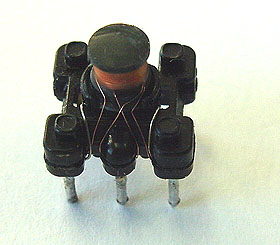 House removed
House removed
Here is the house removed.
You can see the primary winding going from pin1 to pin3. They have made a tap
connetion to pin 2.
If you look close you will see the leads from the capacitor comming up (shining
wire) and connect to pin1 and pin3.
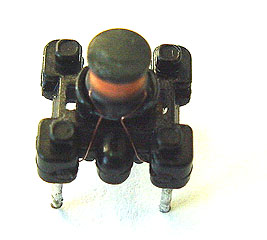 Backside of the can
Backside of the can
This is the backside of the can.
Here you can see the secondary winding connected to pin 4 and pin 5.

[ About me
| Acronyms | CW
| Data Sheets | Docs
| Download | E-mail
| HOME | Ham
projects | Hobby
circuits | Photo galery
| PIC | QTH
photos |
Sign
in my guestbook | View
my guestbook ]
© 2001 - YO5OFH, Csaba Gajdos

 Quadrature FM Detectors
Quadrature FM Detectors



 House removed
House removed Backside of the can
Backside of the can